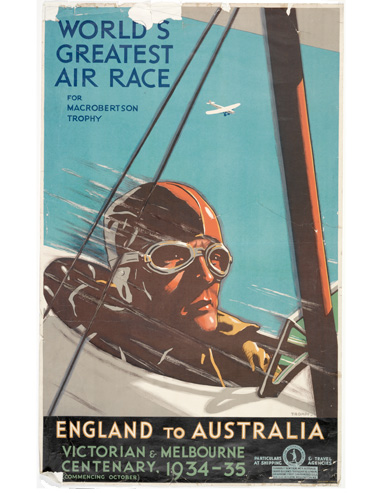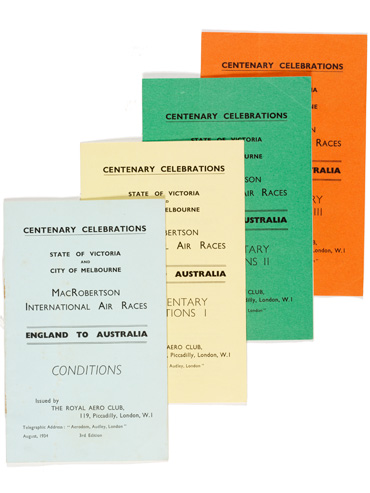MacRobertson Centenary Air Race
A spectacular flying race was held in 1934 to celebrate Melbourne's 100th anniversary. The 1934 MacRobertson Centenary Air Race from Mildenhall (near London) to Melbourne was divided into two divisions – speed and handicap – with no limits to aircraft size, power or crew. The sponsor, Australian confectionary mogul, Sir Macpherson Robertson, provided a prize pool of £15, 000. Initially, there were 64 entrants from 13 countries, but when the race started on 20 October 1934, the field had been reduced to 20 planes from seven countries. Only 11 finished the gruelling 18,000 kilometre trip.
The route stretched over 19 countries and seven seas. Five compulsory stops were designated for both divisions. Between the five stops (Baghdad, Allahabad, Singapore, Darwin and Charleville) pilots could select their own route.
> View selections from the Guiding brochure and route handbook issued to the entrants
> Examine an annotated map of the trip
Winners of the speed division of the race were British fliers C.W.A. Scott and T. Campbell Black in a red DeHavilland 88 Comet, named Grosvenor House. They reached Melbourne in two days, 23 hours, 18 seconds, with a total air time of 71 hours.
Winner of the handicap division, and second fastest with an air time of 81 hours 10 minutes, was the Dutch airliner Uiver (Stork). Crewed by Parmentier, Moll, Prins and Van Brugge and carrying three passengers, the Douglas DC2 was entered by KLM airlines and showed that passenger air travel could be comfortable, safe and reliable. Uiver suffered a near disaster when a the crew became lost in a storm over Albury, NSW. Residents, alerted by the local radio announcer, scrambled to bring their cars to the racecourse where rows of headlights guided the plane down to land. The next day it had to be dragged out of the mud to continue in the race to Melbourne.
> View images of Uiver being pulled from the mud at Albury on the Library's catalogue ![]()
The only Australian to complete the race was C.J. (Jimmy) Melrose, who flew a DH 80A Puss Moth named My Hildegarde. After 120 hours flying time Melrose landed in Melbourne claiming second place in the handicap division.
Acclaimed aviator Charles Kingsford Smith did not compete, as he was unable to register his second-hand Lockheed Altair, Lady Southern Cross, in time to reach the start.
> View images of pilots and planes involved in the 1934 race
The MacRobertson Centenary Air Race signified the beginning of a new era in aviation. It proved that the new stressed metal aeroplanes performed better over long distances than wooden-bodied machines. It also proved that air travel was a viable alternative for international passenger transport, paving the way for aviation in international travel.
 World's greatest air race for MacRobertson trophy
World's greatest air race for MacRobertson trophyEngland to Australia, Victorian & Melbourne
Centenary, 1934-35
Poster POSTERS 1006
 MacRobertson International Air Races, England to
MacRobertson International Air Races, England toAustralia, conditions & supplementary regulations.
London : Royal Aero Club, 1934.
Printed pamphlets 93/889


